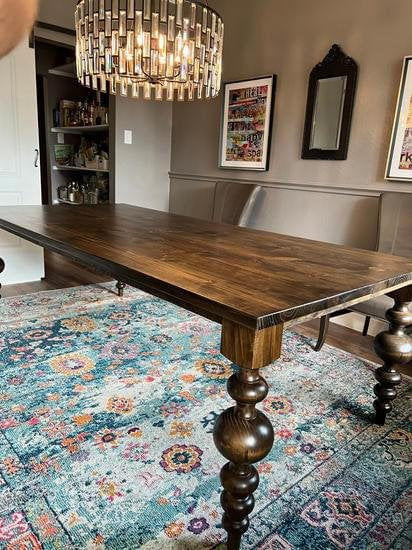Add Charm and Elegance to Your Space with Distinct Dining Room Table Legs
Wiki Article
From Standard to Modern: Find the Perfect Dining Space Table Legs for Your Design
While timeless styles such as cabriole and turned legs stimulate a feeling of classic refinement, modern designs like barrette and geometric alternatives provide a possibility for striking aesthetic rate of interest. As you consider these components, the concern remains: how can you effortlessly integrate these varied leg designs to produce an unified dining experience?Comprehending Table Leg Styles
The variety of dining area table leg designs can dramatically affect both the looks and functionality of the room. Each leg style contributes special functional functions and visual components, satisfying diverse style choices and usage demands. Understanding these designs is critical for selecting the right dining table that lines up with your total indoor layout vision.As an example, conical legs provide a tidy, traditional look that can enhance a room's beauty, while pedestal bases give security and maximize legroom, making them suitable for smaller rooms. Hairpin legs, a hallmark of mid-century modern-day layout, introduce a commercial style, enabling a ventilated, open feel. Likewise, trestle legs evoke rustic appeal, supplying robust assistance and a sense of timelessness.
Wood legs can bring heat and appearance, whereas metal options frequently share a sleek, modern vibe. Ultimately, understanding table leg styles is vital for producing a cohesive dining area that reflects individual style while making sure practicality and convenience.
Traditional Table Leg Options
When picking dining room table legs, conventional options often symbolize ageless beauty and workmanship. These styles reflect an abundant heritage and a dedication to high quality, making them perfect for those who value timeless appearances.One of the most renowned conventional leg styles is the cabriole leg, identified by its stylish rounded form. This design typically features attractive makings and is most commonly located in Queen Anne and Chippendale furnishings. Another prominent alternative is the transformed leg, which flaunts a series of smooth, rounded shapes that offer a traditional look while maintaining stability.
Moreover, the straight leg, while simple, uses a unadorned and durable structure that can mix perfectly with a selection of tabletop designs. For those drawn to ornate outlining, claw-and-ball feet legs stimulate a feeling of grandeur and can function as a spectacular focal factor in any type of eating room.
Finally, pedestal bases, although not strictly legs, supply a different conventional alternative that enables enough legroom and can be perfectly carved. Each of these conventional leg styles adds to the total atmosphere of an eating space, marrying function with aesthetic allure.

Modern Table Leg Layouts
Modern table leg styles offer a diverse series of designs that stress clean lines and ingenious materials. These styles typically focus on functionality while working as striking centerpieces within an eating area. Minimal visual appeals are common, with legs crafted from products such as metal, glass, and crafted wood, which add to a ventilated and contemporary feeling.One popular design is the hairpin leg, characterized by its slim, conical structure that provides stability without frustrating the tabletop (dining room table legs). This design is typically found in mid-century contemporary furnishings and can effortlessly complement numerous dining table forms. Another fad is making use of geometric shapes, where legs may tackle asymmetrical or angular types, including visual rate of interest and a touch of artistry

Mixing Designs for One-of-a-kind Rooms
Often, house owners seek to develop special dining spaces that show their individual design by blending various layout elements. This approach allows for the incorporation of diverse visual appeals, causing an unified yet distinctive setting. As an example, pairing a rustic wood table with sleek, contemporary steel legs can create an eye-catching contrast that boosts the room's overall charm.Furthermore, integrating vintage table legs with modern tabletops can stimulate a sense of background while maintaining a modern perceptiveness. Such mixes not just showcase specific preference but also encourage imagination, enabling homeowners to curate a room that feels both individual and welcoming.
Color plays a crucial function in this mixing procedure; choosing table legs that complement or comparison with the existing color pattern can enhance aesthetic passion. For instance, whitewashed legs can soften the daring of a dark table surface area, developing additional hints a well balanced visual.
Tips for Choosing the Right Legs
Picking the right table legs is crucial for achieving both capability and visual charm in your dining room. Begin by taking into consideration the general design of your area. Typical settings profit from legs that feature complex makings or transformed layouts, while modern areas might require streamlined, minimalist styles.Following, analyze the elevation and security of the legs. dining room table legs. Standard dining tables vary in between 28 to 30 inches in elevation, so ensure the legs enhance this dimension for convenience. Additionally, durable materials, such as hardwood or steel, can boost stability and long life
Evaluate the leg form too-- choices consist of directly, tapered, or pedestal layouts. Straight legs provide a classic appearance, while conical legs can include a touch of beauty. Pedestal bases offer adequate legroom and are ideal for smaller spaces.
Final Thought
In summary, choosing the suitable dining space table legs requires mindful consideration of both standard and modern-day designs. By harmonizing leg design, elevation, and product with the total decoration, a natural and inviting atmosphere can be achieved.The variety of dining area table leg designs can dramatically affect both the appearances and functionality of the room. Inevitably, recognizing table leg styles is necessary for creating a natural eating location that reflects personal style while ensuring functionality and convenience.One of the most legendary standard leg styles is the cabriole leg, characterized by its stylish curved shape. Straight legs supply a classic appearance, while conical legs can include a touch of beauty.In recap, selecting the suitable dining area table legs calls for mindful consideration of both conventional and modern-day designs.
Report this wiki page